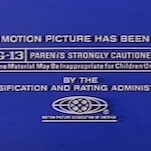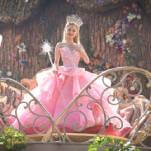Objective information about drugs can be hard to find. The professional scolds over at Partnership For A Drug-Free America certainly can't be counted on to provide unbiased information, nor can the folks at NORML and other pro-drug organizations. Thankfully, movies can always be counted on to deliver objective information, unhindered by sensationalism. Below is a handy guide to drug cinema, designed to help readers make informed decisions about which drugs to abuse and which to avoid.
Drug: Gasoline
A.K.A.: The pump monster, g-death
Movie: Love Liza (2002)
Danger of drug dramatized through: After his wife commits suicide, Philip Seymour Hoffman starts huffing gas.
Nature of high: Gas-huffing apparently causes disorientation and unconsciousness, slows mental faculties, and creates the impression that remote-controlled model planes and boats are cool.
Representative imagery: After Hoffman huffs gas, his face becomes all blurry and distorted, like someone in a Francis Bacon painting.
Tragic consequences: Constantly smelling like gasoline does little for Hoffman's professional life or social standing.
Is rehabilitation possible? The film's final image—Hoffman wandering down the middle of a busy street clad only in socks and underwear—isn't terribly optimistic.
Is the drug good or bad? Unlike most movies about gas-huffing, Love Liza doesn't make it look the least bit cool or romantic.
Drug: LSD
A.K.A.: Acid, Lucy In The Sky With Diamonds
Movie: Psych-Out (1968)
Danger of drug dramatized through: A wide-eyed innocent (Susan Strasberg) runs away from home and heads to San Francisco to find her brother (Bruce Dern). There, she falls in with some hard-drugging, long-haired countercultural types, led by Jack Nicholson.
Nature of high: According to future The Mack star Max Julien, using LSD is like having the universe explode over his head. Hallucinations abound; some involve armor-clad knights and a Technicolor dragon, while others feature spontaneous fires breaking out everywhere. An increased interest in crystals, prisms, and cheap jewelry seems to be a common side effect, as is a fondness for wanky psychedelic bands and dressing like a cast member of Hair.
Representative imagery: Lots of obnoxious hippie dancing, accompanied by projected kaleidoscopic lava-lamp effects. Also, plenty of freaky, messed-up hallucinations.
Tragic consequences: Freaked out on LSD, grating indie-film fixture-to-be Henry Jaglom imagines that his friends are zombies and that his bloody hand needs to be cut off. Jesus lookalike Dern similarly freaks out and burns down a house. Drug neophyte Strasberg is nearly hit by a car.
Is rehabilitation possible? Possibly. Acid casualty Dern doesn't seem long for the world, but Strasberg and Nicholson seem to get their shit together.
Is the drug good or bad? Bad, for the most part, though Nicholson and his band of space cadets make some beautiful music while loaded.
Drugs: Marijuana
(with a side order of LSD)
A.K.A.: Reefer, grass, smoke, bud, the chronic, the sticky icky, wacky tobaccy, Mary Jane, jive
Movie: Around The Fire (1999)
Danger of drug dramatized through: A troubled youth (Devon Sawa) descends into a nightmare world of reefer, goofy dancing, and substandard personal hygiene when he decides to follow a conspicuously unnamed jam band. After getting caught by the fuzz, he ends up in rehab, where he learns firsthand that using drugs and listening to interminable jam sessions simply don't mix.
Nature of high: Marijuana results in people enjoying such bands as Phish and The String Cheese Incident. It also turns longtime users into angry, abusive assholes (see also Thirteen). A newfound appreciation of tie-dye appears to be another harrowing side effect.
Representative imagery: Numerous scenes of hippies engaged in a freeform tribal dance à la the rave scene in The Matrix Reloaded, only way lamer.
Tragic consequences: Beyond listening to lots of bad hippie music and dancing like a jackass? Jail, rehab, parental disapproval.
Is rehabilitation possible? Yes. After leaving rehab, Sawa can look forward to a lifetime of listening to jam-band music while sober. The film considers this a happy ending.
Is the drug good or bad? Anything that causes people to willingly listen to The String Cheese Incident is bad news.
Drug: Pretty much all of them
Movie: Thirteen (2003)
Danger of drug dramatized through: In this contemporary update of Reefer Madness, a good girl (Evan Rachel Wood) goes wild to fit in with a slutty, evil popular girl (Nikki Reed), who goes all the way with boys outside the sacred covenant of marriage. Histrionic melodrama ensues.
Nature of high: Apparently, wasted people find their own facial texture endlessly fascinating and wish to be punched repeatedly by their friends.
Representative imagery: Crazy camera movements, blurry neon signs, and sped-up film à la Benny Hill are used to convey the disorientation of being out of one's mind on all sorts of crazy shit.
Tragic consequences: Back-sassing parents, failing in school, dressing like a skank, making numerous inappropriate comments about one's posterior, raging bi-curiosity, threesomes, a dramatic and instant change in personality.
Is rehabilitation possible? Unclear. The ending is the film's only ambiguous element.
Is the drug good or bad? Bad. According to Thirteen, even a few days of drug use can turn Strawberry Sunshine into a pint-sized Squeaky Fromme.
Drug: Heroin, mainly
(but also diet pills and other drugs)
A.K.A.: Smack, Sweet Lady H, The Dragon
Movie: Requiem For A Dream (2000)
Danger of drug dramatized through: Two heroin addicts (Jared Leto and Marlon Wayans) plan a big score that will allow them to relax in heroin-addicted bliss. Somehow, this seemingly foolproof plan doesn't quite pan out. Meanwhile, Leto's mother (Ellen Burstyn) fights her own diet-pill addiction.
Nature of high: Diet pills result in jitteriness, hallucinations, and insanity. Heroin use leads to unquenchable desire for more heroin use.
Representative imagery: Like Thirteen, Requiem employs sped-up film à la Benny Hill. (What was that dude on?) It also cuts to a new shot roughly every nanosecond to suggest intoxication. A diet-pill-crazed Burstyn hallucinates that she's on a demonic motivational show and imagines that delicious sweets and fatty foods are flying at her from the ceiling.
Tragic consequences: Jail, nasty puncture wounds, theft, vivisection. Leto's girlfriend (Jennifer Connelly) is reduced to performing a sex show with another woman in front of a leering crowd of horny businessmen. This is nowhere near as hot as it sounds.
Is rehabilitation possible? Hell, no. Requiem is a little on the bleak side. Abandon hope, all ye who rent this.
Is the drug good or bad? Anti-drug propaganda doesn't get much stronger than this. It's even more unnerving than that episode of Punky Brewster where the bad girls try to get Soleil Moon Frye to try some "nose candy."







































